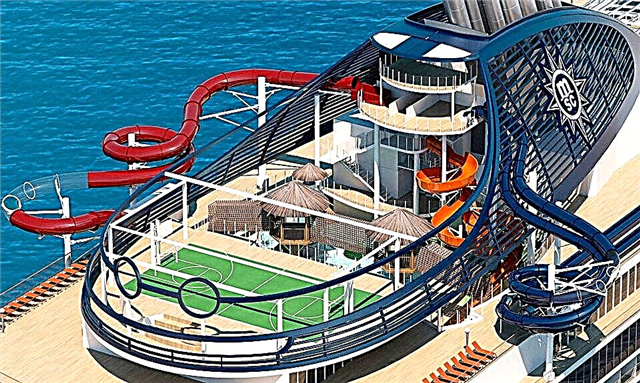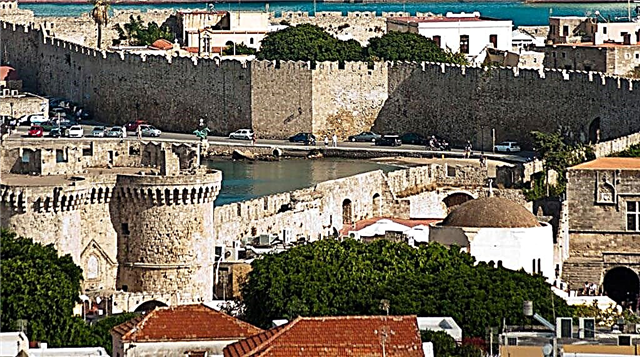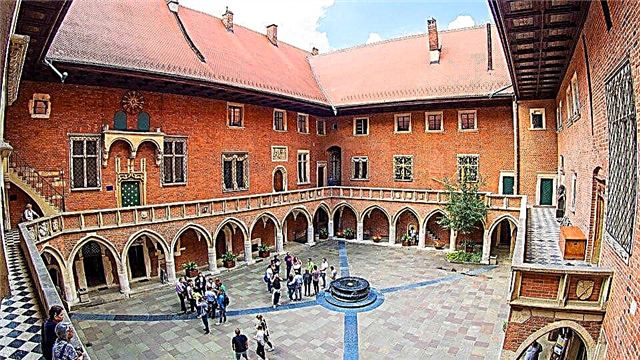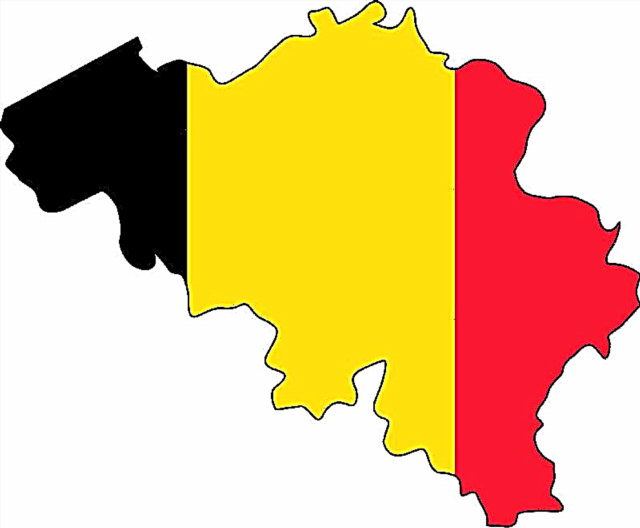Address: Russia, Nizhny Novgorod region, Nizhny Novgorod, Gorky street, 141A, on the territory of the park I.P. Kulibina
Start of construction: 1781 year
Completion of construction: 1785 year
Architect: Ananyin Ya.A.
Coordinates: 56 ° 18'54.6 "N 44 ° 00'23.3" E
Content:
Both in Catholicism and in Orthodoxy, All Saints Churches are dedicated to the Christian holiday - the Council of All Saints. In Orthodox churches, it is celebrated on the first Sunday after Trinity, and Catholics - on November 1. In Nizhny Novgorod, such a dedication was received by the former cemetery church, which now stands in the Kulibin park. This is the only surviving example of the Russian baroque of the late 18th century in the city.

General view of the church
Temple history
In former times, the dead were buried in churchyards at rural and city churches. In the last third of the 18th century, urban planning reforms initiated by Empress Catherine II took place in Russia. The Empress wished to see Russian cities arranged in a European way - with large squares and straight streets, convenient for transport. Together with the planning of new streets and buildings, all city services were put in order - hospitals, schools, cleaning of territories from garbage and, of course, cemeteries. Each city, including Nizhny Novgorod, has its own urban reorganization plan.
Church graveyards became one of the biggest challenges faced by town planning commissions in 1763. Local residents strongly objected to the construction of new city streets on the territory of old cemeteries. Unable to settle the problems in other ways, the Senate in 1771 ordered the city authorities in Russia to stop burials at city churches. From that time on, they were obliged to allocate special plots of land for cemeteries outside the city blocks - on pasture fields where cattle were usually grazed.
In 1775, in Nizhny Novgorod, they determined the place where the first citywide cemetery was to be created. It was located 0.5 versts outside the city outskirts, on the so-called Barbarian Field. This territory was surrounded by a fence and a chapel was placed inside. They began to equip the new cemetery with joint efforts, and for this purpose a fundraising among the residents was specially announced.
At the same time, during the redevelopment of the city, it was decided to demolish the old Peter and Paul Church, which stood under the Kremlin Hill, where the Alexander Garden now begins. The first mention of this temple dates back to 1621. The priest and parishioners really wanted to preserve their parish and suggested that the city authorities build a new Peter and Paul Church at the citywide cemetery. This construction was sponsored by Nizhny Novgorod merchants - brothers Averyan, Yegor and Evdokim Neudakin, who were parishioners of the old Peter and Paul Church, as well as other residents of the city.
Nizhny Novgorod provincial architect Yakov Ananievich Ananyin created a project for the future church. By December 1781, the construction of the building was completed, and the builders began to decorate the temple. In the same year, Bishop Anthony of Nizhny Novgorod consecrated the first chapel of the church in honor of Saints Constantine and Helena. Two more years later, another side-altar was consecrated in the church, dedicated to St. Basil of Paris and Peter of Alexandria.

View of the north facade of the church
And, finally, 4 years after the completion of the construction, the Bishop of Nizhny Novgorod Damaskin (Rudnev) consecrated the main temple altar - in honor of the apostles Peter and Paul (1785). According to the customs that existed at that time, almost all cemetery churches were traditionally called All Saints. Therefore, the residents of Nizhny Novgorod began to call the new temple both All Saints and Peter and Paul.
The cemetery territory was constantly improved. In 1855, a wooden chapel was erected here, and 12 years later it was replaced by a stone one. In this chapel, memorial services were held for those who died in hospitals, who did not have relatives and wanderers. Here, for a short time, coffins with the dead were left. Another chapel was located near the entrance to the cemetery.
Throughout its history, the temple has also undergone several reconstructions. In 1889, its tent-roofed bell tower was extended with one more tier, and it became 8.5 m higher. 5 years later, the restoration was carried out inside the church. The carvings of the saints on the carved gilded hipped-roof iconostasis, built in 1784, were replaced with new icon-painting images. Ancient icons of the Kazan and Vladimir Mother of God (17th century) were considered especially revered temple shrines.
During the Soviet era, in 1939, the Church of All Saints was closed, and the old church bell tower was destroyed. Later, the temple premises were used as the Pioneer cinema. For this, the altar was reconstructed by attaching a movie booth to it. In addition, the western part of the temple, where the audience was sitting, was modified. Later, a disco and a billiard room were opened in the church building. In addition, the temple was used as a living quarters.
In the 1990s, the church was returned to the parishioners. A new three-tiered bell tower appeared at the temple quite recently - in 2014.
Kulibin park
In the place where the park is now located, there was a cemetery - one of two in the city. And most of the deceased residents of Nizhny Novgorod were buried on it. It is known that many eminent officials, merchants and writers were buried at the Peter and Paul Cemetery.
By the beginning of the last century, the cemetery area was located between Field Street, which now bears the name of M. Gorky, and Napolno-Lesnaya Street. Part of it in our times is called V.G. Belinsky. They continued to bury in this cemetery until 1937, despite the violation of all sanitary standards existing in the city.

View of the eastern facade of the church
In 1939, the City Council decided to liquidate the old cemetery and create a park area in its place. It was named after the famous Nizhny Novgorod citizen, gifted mechanic Ivan Petrovich Kulibin. When they began to lay out park paths and alleys, the nearby Vsekhsvyatsky lane, in which the priests traditionally lived, was renamed Granitny (1940). According to some sources, the old gravestones and crypts were taken out, according to others, they were smashed into pieces and covered with earth. Of the old burials, only two have been preserved - the burial places of I.P. Kulibin (1818) and Akulina Ivanovna Kashirina, the grandmother of the writer Alexei Maksimovich Gorky. At the same time, a bust of the Nizhny Novgorod inventor, made by the sculptor A.V. Kikin.
The development of the park was interrupted by wartime, but continued after the end of the Great Patriotic War. Many new trees have appeared here. By the 1960s, a monument to Maxim Gorky, a dance floor and several park attractions were erected in the park, and the Sputnik cinema was also built. By the 1990s, all recreational facilities had been removed. And now there are only two cafes and a warehouse (former shooting gallery) in the park area.
It is known that earlier soldiers who died during the First World War were buried in mass graves in the old cemetery. In 2014, a small chapel was erected in the park in memory of them. Today the entire complex of park structures and an area of 24 hectares with old trees have been declared a cultural heritage site.
Architectural features of the church
The pillarless temple is built in the traditional style - an octagon on a quadrangle. The church is built in the shape of a "ship" - the temple itself, a one-story refectory and a bell tower are stretched in one line from east to west. The illuminated octagon of the church is decorated in the tradition of the Baroque - hewn from bricks architraves.
On the western side of the All Saints Church is the memorial complex of I.P. Kulibin - his gravestone and a stele with a high-relief portrait of the inventor, created from black granite by the sculptor P.I. Gusev (1985).

The main facade of the church, in the foreground is a tombstone on the grave of I.P. Kulibina
The current state of the temple and the visiting regime
The Orthodox Church is active and open to all comers. Church services are held here on Saturdays, Sundays and public holidays at 8.00 and 16.00. The patronal feast is celebrated on July 12th.
For the children of parishioners and pupils of the Nizhny Novgorod boarding school No. 7, a Sunday school has been created at the church. For adults, an Orthodox lecture hall is open on Thursdays at 17.00. In addition, at the All Saints Church there is a obstetrics center named after Seraphim of Sarov.
How to get there
The church is located in the central part of the city, in the Kulibin park, on the territory of the Nizhny Novgorod region, at the address: st. Gorky, 141A. It is easy to walk from the Gorkovskaya metro station (0.8 km). In addition, the temple can be reached by city buses or fixed-route taxis (stop "Cinema" Sputnik ").











